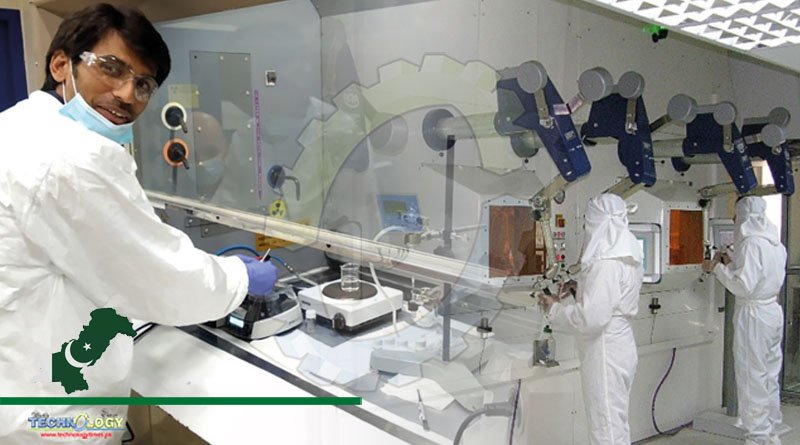Opportunity knocks for Pakistan, with the R&D collaboration between PINSTECH and MEDICIS critical to the country’s long-term goal of strengthening technical capability.

Domestic effort of Pakistan to scale up commercial production of medical radioisotopes leverages a fruitful R&D collaboration with CERN’s MEDICIS facility, as Moazam Mehmood Khan, Umair Khalid, Zafar Yasin, and Shabana Saeed explained.
The Pakistan Atomic Energy Commission (PAEC) serves as a hub for the country’s various scientific, technological, and engineering collaborations with CERN and other world-class international accelerator facilities. Zoom in a little more, and one of the collaborative effort’s engine rooms is prominently displayed: the Pakistan Institute of Nuclear Science and Technology (PINSTECH).
PINSTECH, headquartered in Islamabad, is a premier R&D institute within PAEC and, by extension, one of Pakistan’s leading research institutions. The institute’s broad research programme includes isotope production and applications, materials science, radiation protection and health physics, and neutron science.
Two operational nuclear research reactors supplement this R&D effort: Pakistan Research Reactor-1 is a 10 MW pool-type reactor that produces radioisotopes for medical applications; Pakistan Research Reactor-2 is a smaller reactor that is primarily used for neutron activation and teaching/training purposes.
PINSTECH operates facilities for the production of a variety of reactor-based radioisotopes, including 99Mo, 99mTc generators, 131I, and 32P, which are continuously supplied to nuclear medicine centres across the country. PINSTECH‘s production of freeze-dried radiopharmaceutical in-vivo diagnostic kits for nationwide distribution is a critical component of this programme.
Scientists and engineers from PINSTECH have been seconded to the CERN-MEDICIS team to work on a variety of radiochemical activities. CERN-MEDICIS image credit
During radioisotope production, target materials are placed into the research reactor for neutron irradiation, after which the irradiated targets are transferred into the “hot cells” of the facility for chemical separation, purification, quality control, and dispatch.
The Pakistan Nuclear Regulatory Authority and the Pakistan Drug Regulatory Authority oversee the entire production process.
Researchers at PINSTECH are also working on a 5 MeV electron linac for radiotherapy applications, with support from CERN, as part of a national effort to scale technical capacity and capability in medical accelerator technologies.
Collaboration is hardwired into PAEC’s operational model, and as such, it underpins Pakistan’s radioisotope production program. PAEC and the International Atomic Energy Agency (IAEA), for example, have been collaborating in this area for many years and have completed a number of successful technical cooperation projects (with a joint project in the healthcare sector currently under way at the national level).
CERN is another prominent R&D partner, with PINSTECH and the CERN-MEDICIS facility collaborating on the production and study of novel radioisotopes for medical diagnostics and treatment. Specifically, the two organisations are conducting R&D on the production of novel medical (reactor- and accelerator-produced) radioisotopes such as 195 mPt, 165 Er, 225 Ac, 155 Tb, 161 Tb, and 177 Lu, an endeavour that the two partners hope will eventually lead to clinical trials.
The bottom line is that Pakistan, which has a high cancer mortality and morbidity rate among its 220 million population, is eager to use cutting-edge radioisotope science for large-scale cancer diagnosis, treatment, and management.
The Islamic Republic of Pakistan became an associate member of CERN in 2015, formalising a much older relationship. In order to put this in context, Pakistan and CERN signed a cooperation agreement in 1994, which was followed by the signing of several protocols. Pakistani scientists and engineers now contribute to the ALICE, CMS, ATLAS, and MEDICIS experiments, as well as accelerator projects such as CLIC/CTF3 and LINAC4.
Pakistan contributed significantly to CMS tracker alignment, as well as the construction and installation of 320 resistive plate chambers and the assembly and testing of gas electron multiplier detectors. CMS and ALICE computing, the WLCG, and data analysis, as well as operating one of the Tier-2 centres, have all made significant contributions. Pakistan is currently contributing to the mechanics and electronics of the HGCAL.
Pakistani teams also built critical components of the experimental infrastructure, such as the feet that support the entire barrel yoke, the outermost end-cap discs, and the removable tower that supports the forward hadron calorimeter.
In addition, Pakistan built various mechanical components for ATLAS and the LHC and significantly contributed to the LHC consolidation programme in 2013–2014.
PINSTECH scientists and engineers have been seconded to the CERN-MEDICIS team to develop radiochemical activities, including a significant contribution to the MEDICIS radiochemistry set-up for the purification of medical radioisotopes with both therapeutic and diagnostic properties (so-called “theranomic” combinations).
PINSTECH engineers have also been working on the development of salt/aluminum foils for radioisotope collection, the management of liquid radioactive waste at MEDICIS, a very promising R&D project involving the production of 195 mPt for theranostic applications, and the development of a large-scale radiochemistry unit for dealing with higher levels of radioactivity.
The regular exchange of radioisotopes between the two partners is central to the PINSTECH-MEDICIS collaboration. For example, research quantities of 225Ac were recently shipped from CERN to Pakistan and transferred to the Lahore-based INMOL cancer clinic after chemical processing at PINSTECH (another PAEC facility). In this case, the 225Ac was used in the radio labelling of a specific “theranostic module” (the chemical reaction to produce the radiopharmaceutical took about 30 minutes and yielded a higher yield than 95%).
Opportunity knocks for Pakistan, with the R&D collaboration between PINSTECH and MEDICIS critical to the country’s long-term goal of strengthening technical capability, commercial capacity, and production infrastructure in order to secure a scalable domestic pipeline of novel and high-impact theranostic radioisotopes.